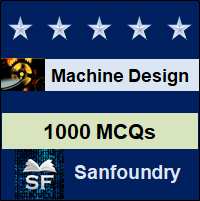This set of Machine Design Questions & Answers for experienced focuses on “Threaded Joints:Basics & Cap Screws”.
1. Threaded joints are non-separable joints.
a) True
b) False
View Answer
Explanation: Threaded joints are separable joints of machine parts that are held together by means of a threaded fastening such as nut and bolt.
2. Which type of joints is better when the product is subjected to large vibrations: welded or threaded?
a) Welded
b) Threaded
c) Both have same results
d) Depends on the magnitude of the vibrational force
View Answer
Explanation: Threaded joints loosen when subjected to vibrations.
3. If a fastener is threaded into a tapped hole, then the fastener is likely to be called as
a) Screw
b) Bolt
c) Washer
d) Screw or bolt
View Answer
Explanation: Bolt is threaded into a nut while screw is threaded into a tapped hole.
4. In nut and bolt fastener, nut is generally held stationary while bolt is rotated.
a) True
b) False
View Answer
Explanation: Bolt is always held stationary while nut is rotated.
5. Which of the following is not a function of washer?
a) Distributes load over a large area of clamped parts
b) Provides bearing surface over large clearance bolts
c) Prevents marring of the bolt head and nut surface
d) Helps in locking of the fastener
View Answer
Explanation: Washer doesn’t help in locking of fasteners.
6. Shank is the portion of bolt between the head and the thread.
a) True
b) False
View Answer
Explanation: Shank is the portion between head and the thread of the bolt.
7. If there is no place to accommodate the nut, then one would choose the
a) Through Bolts
b) Tap Bolts
c) Studs
d) None of the mentioned
View Answer
Explanation: Tap bolts are directly threaded into the clamped parts and does not require any nut.
8. Which of the following are good for parts that are seldom dismantled.
a) Through Bolts
b) Tap Bolts
c) Studs
d) Cannot be stated
View Answer
Explanation: Tap bolts, if removed frequently will leave the threads in the part worn out and hence are used where dismantling is rare.
9. Which of the following requires more space for the rotation of spanner?
a) Square Head
b) Hexagonal Head
c) Both require equal space of rotation
d) Cannot be stated
View Answer
Explanation: Angle of rotation for hexagonal head is one sixth of a revolution to enable the next pair of flats to be engaged while it is one fourth of a revolution in case of square head.
10. Fillister, button, flat and hexagonal heads are all tightened externally.
a) True
b) False
View Answer
Explanation: All of these are internal drive screws having a slot for the screw driver of different shape on the head.
11. Set screws are subjected to tensile forces only.
a) Yes
b) No, they are subjected to compressive forces only
c) Both compressive and tensile
d) Can’t be determined
View Answer
Explanation: Set screws are subjected to compressive forces only.
12. If the lateral force acting on the set screw is large and tends to displace one part with respect to other than which point is recommended?
a) Dog Point
b) Cone Point
c) Window Point
d) Cut Point
View Answer
Explanation: Dog point is used when the lateral force is large provided the part has sufficient thickness to accommodate a cylindrical hole for dog point.
Sanfoundry Global Education & Learning Series – Machine Design.
To practice all areas of Machine Design for experienced, here is complete set of 1000+ Multiple Choice Questions and Answers.
If you find a mistake in question / option / answer, kindly take a screenshot and email to [email protected]
- Practice Metallurgical Engineering MCQs
- Apply for Mechanical Engineering Internship
- Check Machine Design Books
- Check Metallurgical Engineering Books
- Check Mechanical Engineering Books

